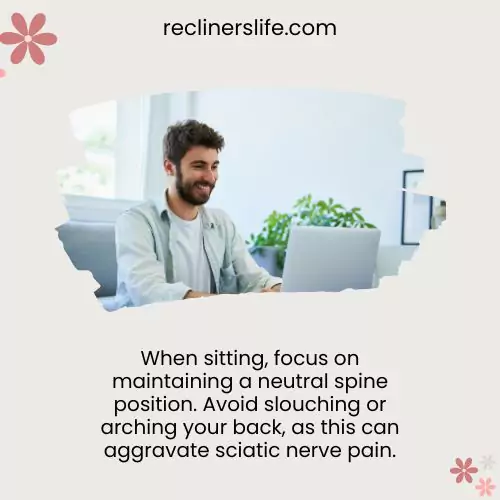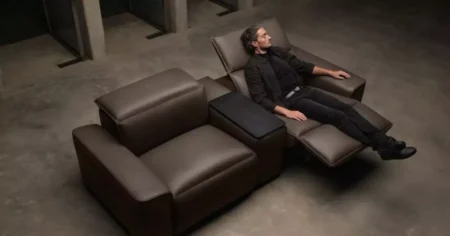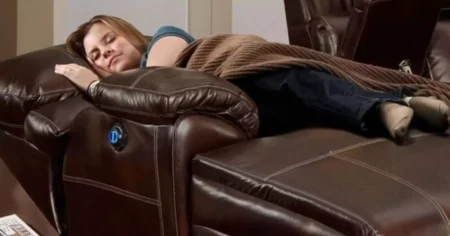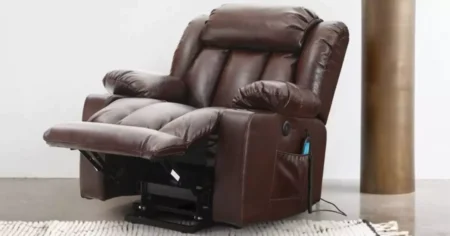Yes, a recliner is good for sciatica pain, but only if used correctly. When sitting in a recliner, it is important to keep your back straight and your knees bent.
This will help to reduce pressure on the sciatic nerve and relieve pain. Recliners that have adjustable lumbar support can be especially helpful for people with sciatica.
If you want to know more about sciatica and recliners, keep scrolling.
What is Sciatica?
Sciatica is a condition that affects the sciatic nerve, the longest nerve in the body.
The sciatic nerve runs from the lower back down the back of each leg, and it provides sensation to the leg and foot. Sciatica can cause pain, numbness, and tingling in the leg.
Sciatica is often caused by a herniated disc, which is a condition where a disc in the spine bulges out and puts pressure on the sciatic nerve.
Other causes of sciatica include spinal stenosis, a narrowing of the spinal canal, and piriformis syndrome, a condition where the piriformis muscle, which runs from the buttocks to the thigh, compresses the sciatic nerve.
Is a Recliner Good for Sciatica?
Yes, a recliner can be good for people with sciatica. The reclining position can help to reduce pressure on the sciatic nerve and improve circulation. This can help to relieve pain and inflammation.
How to Sit in a Recliner with Sciatica?
Here are some tips on how to sit in a recliner or on a couch with sciatica:
1. Choose the Right Recliner or Couch
Opt for a recliner or couch that provides good lumbar support and is comfortable for your body.
Look for models with adjustable lumbar cushions or built-in lumbar support to help maintain the natural curve of your lower back.
2. Mind Your Posture
When sitting, focus on maintaining a neutral spine position. Avoid slouching or arching your back, as this can aggravate sciatic nerve pain.

Use the backrest of the recliner to support your back and keep it upright.
3. Practice Gentle Stretching
Before sitting down, perform some gentle stretching exercises to loosen up your muscles and relieve tension around the sciatic nerve.
Stretch your hamstrings, lower back, and glutes for a few minutes.
4. Utilize Cushions or Pillows
Place a cushion or rolled-up towel behind your lower back for extra lumbar support. This additional cushioning will help reduce pressure on your spine and sciatic nerve.
5. Employ Heat Therapy
Applying a heating pad or a warm towel to the affected area can help relax tight muscles and alleviate sciatic pain. Use the heat therapy for about 15-20 minutes before sitting down or during breaks.
6. Take Breaks to Walk and Stretch
Prolonged sitting can worsen sciatic pain. Remember to take regular breaks to walk around and perform gentle stretching exercises. This will improve blood circulation and prevent stiffness.
7. Use an Adjustable Footrest
If your recliner doesn’t have a built-in footrest, consider using an adjustable footrest or ottoman to elevate your legs. Raising your legs slightly can take some pressure off the sciatic nerve.
8. Choose the Right Reclining Angle
Experiment with different reclining angles to find the most comfortable position for your sciatica. Avoid reclining too far back, as it may strain your lower back.
9. Maintain a Healthy Weight
Excess weight can put additional stress on your spine and worsen sciatica.

If you’re overweight, consider adopting a healthy diet and exercise routine to manage your weight and reduce pressure on your sciatic nerve.
10. Consult a Healthcare Professional
If your sciatica pain persists or worsens, it’s essential to consult a healthcare professional, such as a physical therapist or orthopedic doctor.
They can provide personalized advice and treatment options to manage your sciatica effectively.
Here are some additional tips that may help to relieve sciatica pain:
- Stay hydrated. Staying hydrated helps to reduce inflammation, which can contribute to sciatica pain.
- Get regular exercise. Exercise can help to strengthen the muscles around your spine and reduce pain.
- Lose weight if you are overweight. Excess weight can put extra strain on your back and increase your risk of sciatica.
- Avoid smoking and excessive alcohol consumption. Smoking and excessive alcohol consumption can irritate your sciatic nerve and worsen pain.
- Get enough sleep. When you are well-rested, your body is better able to heal itself.
If you are experiencing sciatica pain, it is important to seek medical attention. Your doctor can diagnose the cause of your pain and recommend treatment options.
How To Choose A Recliner For Sciatica?
When choosing a recliner for sciatica, it is important to choose one that has the following features:
- A comfortable seat: The seat should be soft and supportive.
- A reclining mechanism: The reclining mechanism should allow you to adjust the angle of the seat and backrest. This will allow you to find a position that is comfortable and that relieves your pain.
- A footrest: The footrest should be adjustable so that you can elevate your legs.
- A headrest: The headrest should be adjustable so that you can support your neck.
Conclusion
A recliner can be a helpful tool for relieving sciatica pain.
However, it is important to choose a recliner that has the right features and to use it in a way that does not aggravate your pain.
If you are experiencing sciatica pain, it is important to see a doctor to get a diagnosis and discuss treatment options.
Frequently Asked Questions
Can you sleep in a recliner with sciatica?
Yes, you can sleep in a recliner with sciatica. However, it is important to choose a recliner that has good lumbar support and a comfortable seat. You may also want to use a pillow or rolled-up towel to support your lower back.
What is the best sitting position for sciatica?
The best sitting position for sciatica is one that keeps your spine in a neutral alignment. This means sitting up straight with your shoulders back and your feet flat on the floor.
Is it OK to sit in a recliner with lower back pain?
Yes, it is generally OK to sit in a recliner with lower back pain. However, it is important to choose a recliner that has good lumbar support and a comfortable seat.
Is it better to sit on a hard chair with sciatica?
No, it is not generally better to sit on a hard chair with sciatica. A hard chair can put more pressure on your lower back, which can worsen your pain. It is better to sit on a chair that has good lumbar support and a comfortable seat.





